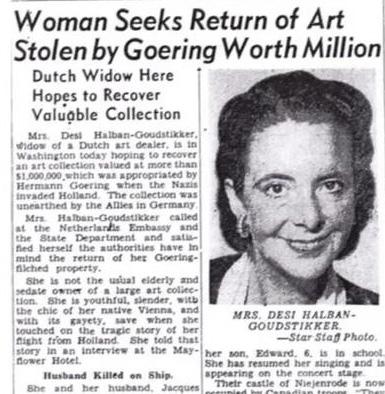Justice and Blindness: Not Mutually Exclusive The rightful return of the Toren Basketweavers painting
ationse of any This piece was originally published in Holocaust Remembered, Vol. 6 in 2019.
T
he 2017 issue of Holocaust Remembered included an article regarding Manhattan attorney David Toren, stripped of his sight by shingles in 2007. The timeline on that article began with Toren, a pubescent boy, escaping on the last Kindertransport, departing his hometown, Breslau, Poland, now known as Wroclaw. More than seven decades later, injusk for tices attendant to the Holocaust continued of of haunting him, now a keen-minded lawyer. g, Two Along with the international art world, he art was rocked by the 2013 discovery of a trove e, and of Nazi-looted art, horded and obscured art for years in the Munich apartment of the reclusive son and heir of an unscrupulous as Nazi-associated art dealer. Toren’s European agent, who had long 305 been searching for art pilfered by Nazis, m his notified his Manhattan client he had just seen the Max Liebermann painting, Two Riders on a Beach, on television. The oil was one of only a few confiscated pieces shown at a news conference as examples from the art raid. Toren’s photographic memory enabled him to thumb through law books he could no longer see. Several fruitless initiatives later, he found a legal loop and filed suit against the Republic of Bavaria for the return of the painting. Along with grit and determination, patience characterized Toren’s tenacious legal maneuvers. Forced justice prevailed in the painting’s return. Family justice prevailed in the disposition of the painting. His brother, the only other family member to survive the Holocaust, also was heir to the painting — and he had heirs. Toren would not be able to see the evocative painting. To achieve family justice, the decision was made to sell the painting. By the time the gavel came down at Sotheby’s of London, his brother had died leaving daughters to share in the proceeds from the painting’s sale — close to $2.5 million. It had been Toren’s distinctive recall of details, from his youth and from his law books, that helped connect the dots leading to the just return of the Liebermann. Equally vivid was his recall of other paintings, as well as ceramics and ivories, in the valuable collection then owned by his great
Max Lieberman, The Basketweavers
uncle David Friedmann, a wealthy Breslau industrialist. Once again, Toren virtually thumbed through the law books with which he was so familiar, ferreting out — from memory — a legal precedent with which he might bring a new suit against Germany for the other art stolen. Like Two Riders on a Beach, another vividly-recalled piece was also by Max Liebermann. The Basketweavers depicts five Dutch boys weaving straw into baskets. Deduction coupled with research, with which he had help, formed Toren’s conclusion the painting was in Israel, not Germany. He was right.
And as it turned out, the unaware owner of The Basketweavers also was a Holocaust survivor. The painting had only been in his possession since 2000; he purchased it at auction in Berlin for 130,000 euros ($139,000.) When the Israeli learned the emotional story surrounding the painting, he could no longer look at it. His attorney, Meir Heller of Jerusalem, told international news media, “This caused him great turmoil; it retroactively sullied the artwork.” Time and attorneys’ negotiations resulted in a solution. Toren said, “The Basketweavers now hangs in my son’s living room. I bought it back from the Israeli,” who donated his
Supplement created and paid for by the SOUTH CAROLINA COUNCIL ON THE HOLOCAUST | APRIL 27, 2022
proceeds to aid needy survivors, Toren learned. Now 91, Toren is legally pursuing the return at least 50 more works of art. His proof of provenance is a detailed inventory, penned by the Nazis who looted his greatuncle’s collection in 1939. “I have recently been notified of Germany’s Motion to Dismiss,” said Toren, who does not give up this easily. ■ Rachel Montgomery Haynie “Bunny” (March 24, 1940-July 23, 2018) was a local freelancewriter, a community connector and a patron of the arts. She wrote for a number of local publications always highlighting the history and art of the Midlands. Rachel was also a prolific author of several published historical biographies.
| HOLOCAUST REMEMBERED
23




















